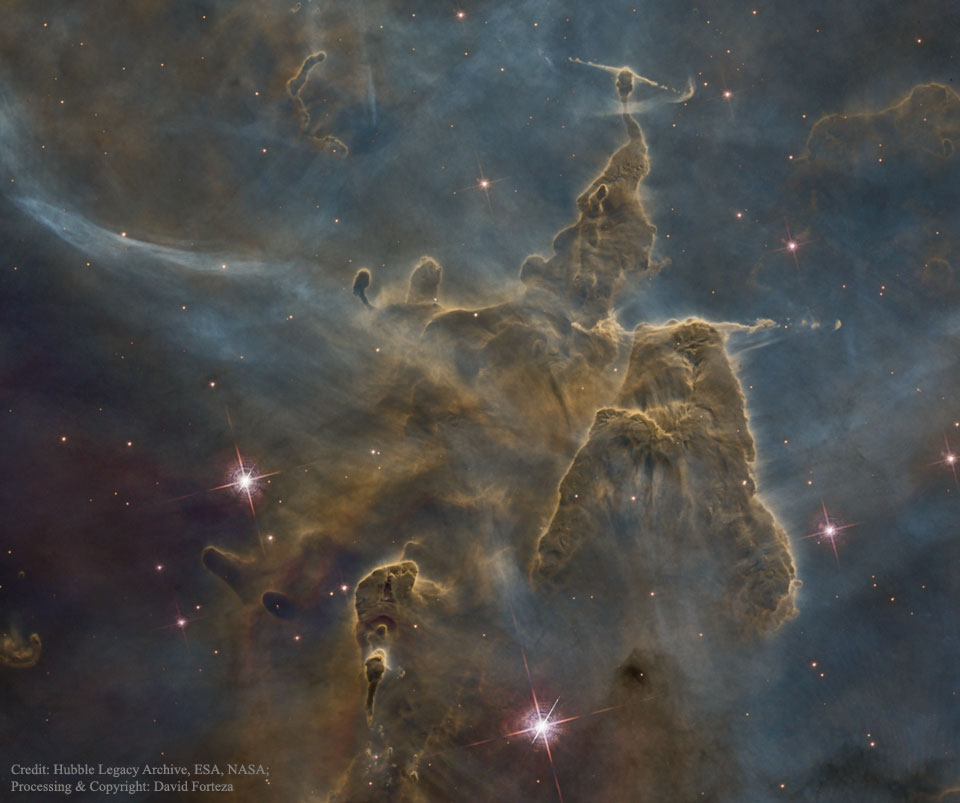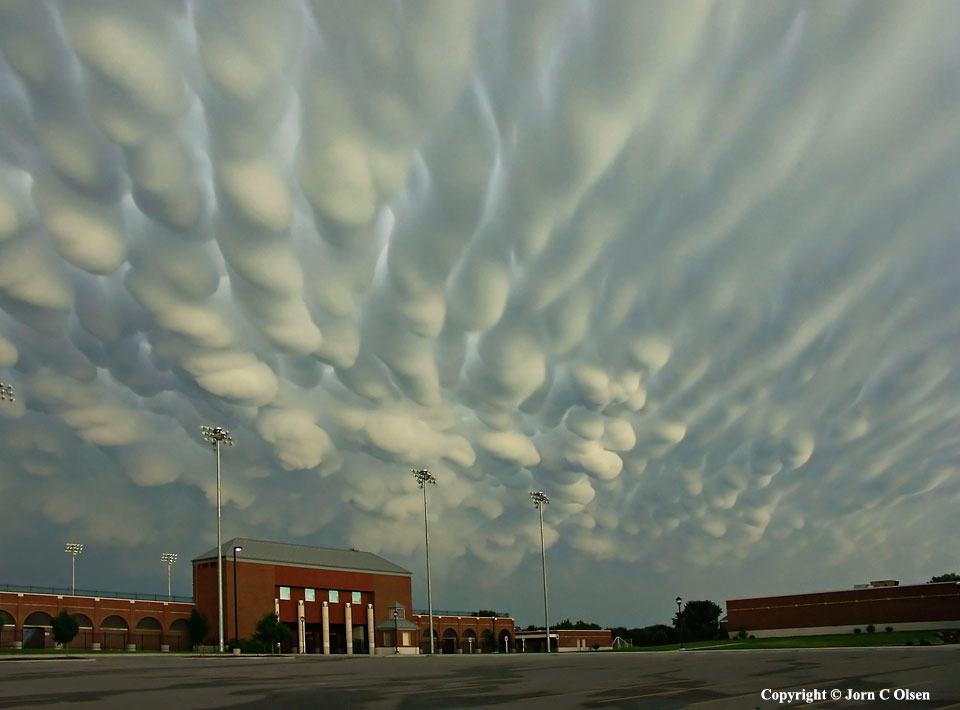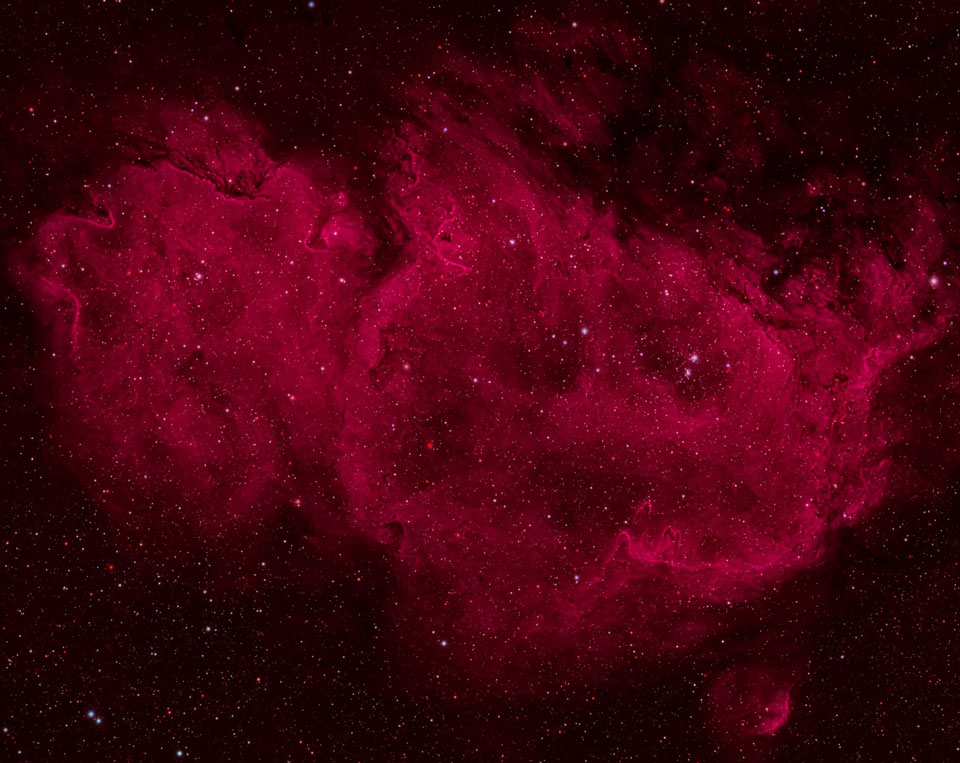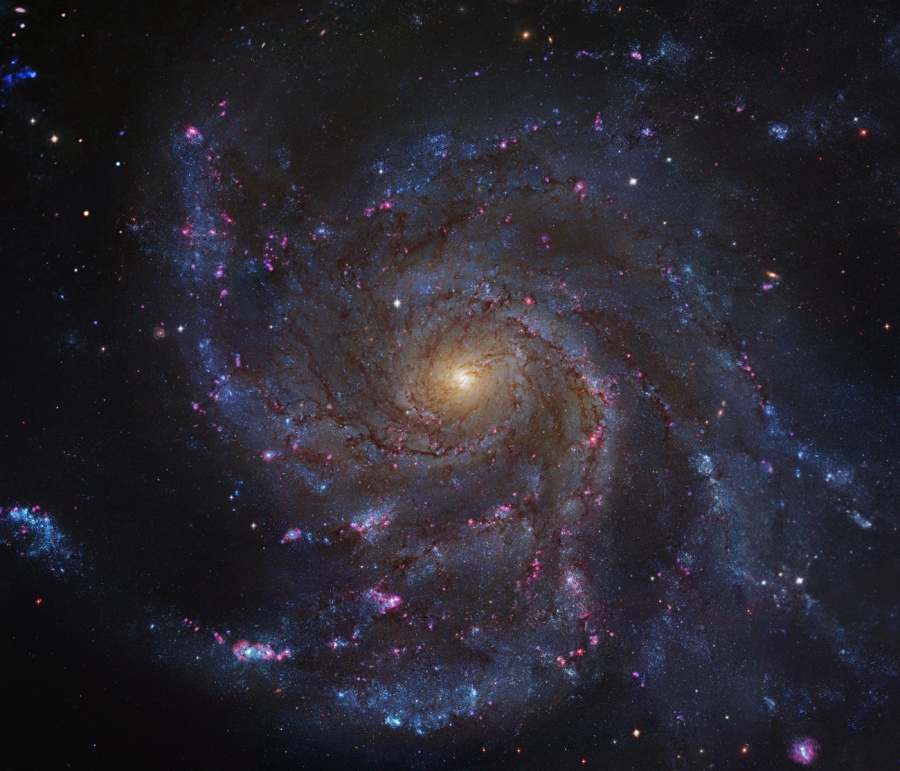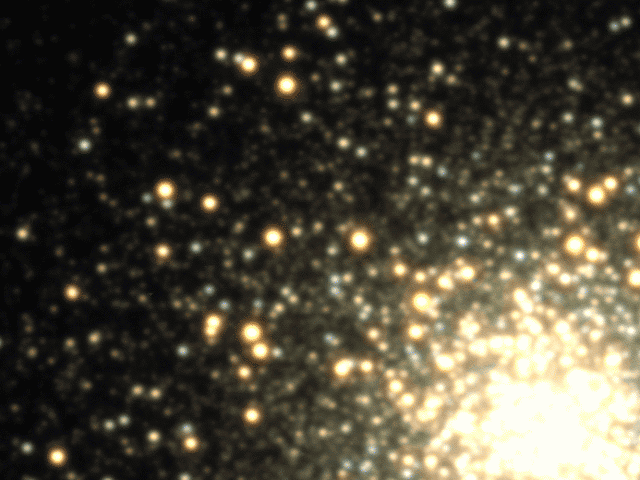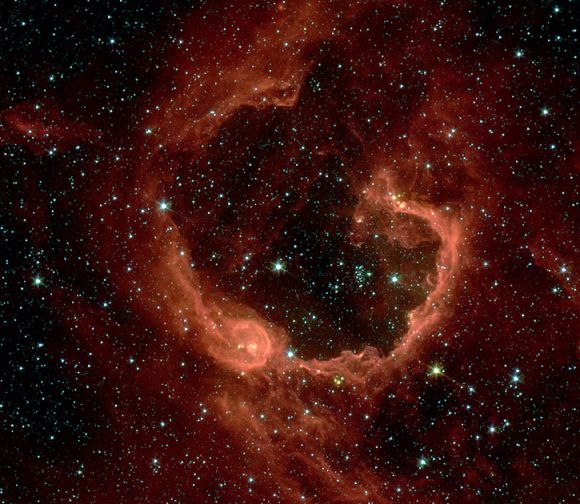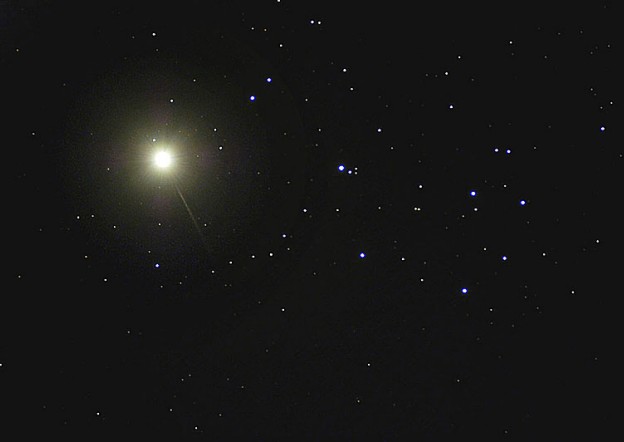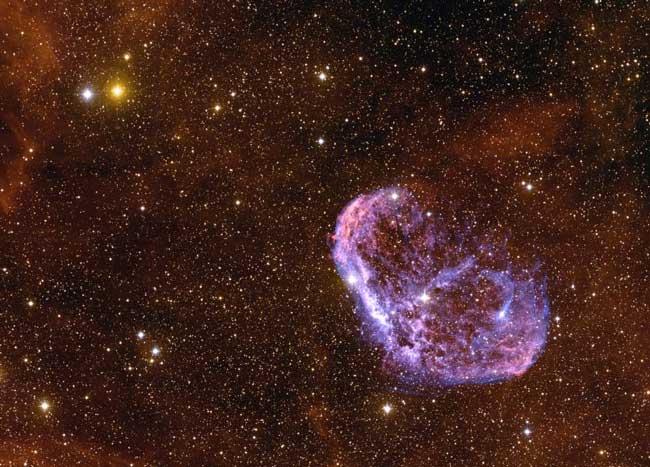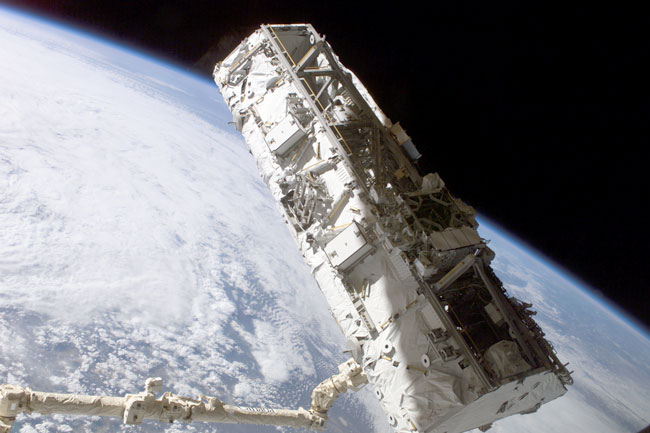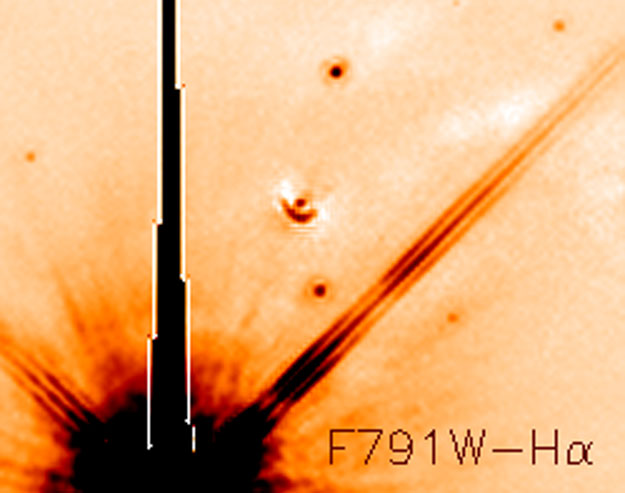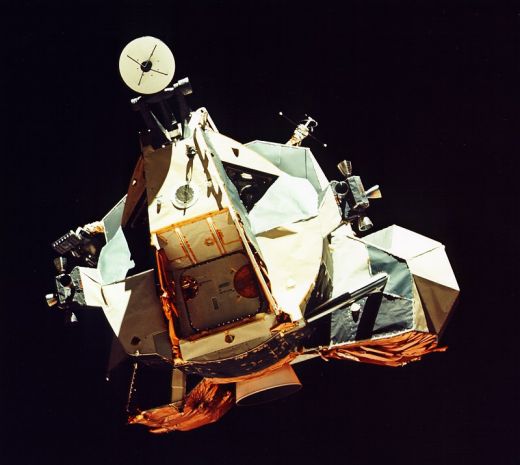| << Previous | Index | Next >> |
2015 It's stars versus dust in the Carina Nebula and the stars are winning. More precisely, the energetic light and winds from massive newly formed stars are evaporating and dispersing the dusty stellar nurseries in which they formed. Located in the Carina Nebula and known informally as Mystic Mountain, these pillar's appearance is dominated by the dark dust even though it is composed mostly of clear hydrogen gas. Dust pillars such as these are actually much thinner than air and only appear as mountains due to relatively small amounts of opaque interstellar dust. About 7,500 light-years distant, the featured image was taken with the Hubble Space Telescope, digitally reprocessed by an industrious amateur, and highlights an interior region of Carina which spans about three light years. Within a few million years, the stars will likely win out completely and the entire dust mountain will be destroyed.
2014 When do cloud bottoms appear like bubbles? Normally, cloud bottoms are flat. This is because moist warm air that rises and cools will condense into water droplets at a specific temperature, which usually corresponds to a very specific height. As water droplets grow, an opaque cloud forms. Under some conditions, however, cloud pockets can develop that contain large droplets of water or ice that fall into clear air as they evaporate. Such pockets may occur in turbulent air near a thunderstorm. Resulting mammatus clouds can appear especially dramatic if sunlit from the side. The mammatus clouds pictured above were photographed over Hastings, Nebraska during 2004 June.
2013 Stars are forming in the Soul of the Queen of Aethopia. More specifically, a large star forming region called the Soul Nebula can be found in the direction of the constellation Cassiopeia, who Greek mythology credits as the vain wife of a King who long ago ruled lands surrounding the upper Nile river. The Soul Nebula houses several open clusters of stars, a large radio source known as W5, and huge evacuated bubbles formed by the winds of young massive stars. Located about 6,500 light years away, the Soul Nebula spans about 100 light years and is usually imaged next to its celestial neighbor the Heart Nebula (IC 1805). The above image appears mostly red due to the emission of a specific color of light emitted by excited hydrogen gas.
2012 Did this mirage help sink the Titanic? The optical phenomenon called Fata Morgana can make strange shapes or a false wall of water appear above a watery horizon. When conditions are right, light reflecting off of cold water will be bent by an unusual layer of warm air above to arrive at the observer from several different angles. A conceptually comparable mirage can make a setting Sun appear strangely distorted or a distant pavement appear wet. One hundred years ago today, such a Fata Morgana mirage might have obscured real icebergs from the clear view of crew onboard the Titanic. Additional evidence for this distortion hypothesis arises from the nearby vessel SS Californian which reported sightings consistent with Fata Morgana mirages. The above Fata Morgana mirage was taken off the US Pacific coast in 2008.
2011 Big, beautiful spiral galaxy M101 is one of the last entries in Charles Messier's famous catalog, but definitely not one of the least. About 170,000 light-years across, this galaxy is enormous, almost twice the size of our own Milky Way galaxy. M101 was also one of the original spiral nebulae observed by Lord Rosse's large 19th century telescope, the Leviathan of Parsontown. This mosaic of M101 was assembled from Hubble Legacy Archive data. Additional ground-based data was included to further define the telltale reddish emission from atomic hydrogen gas in this gorgeous galaxy's star forming regions. The sharp image shows stunning features in the galaxy's face-on disk of stars and dust along with background galaxies, some visible right through M101 itself. Also known as the Pinwheel Galaxy, M101 lies within the boundaries of the northern constellation Ursa Major, about 25 million light-years away.
2010
[imghover6=http://apod.nasa.gov/apod/image/1004/ngc4651_gabany.jpg]http://apod.nasa.gov/apod/image/1004/ng ... gabany.jpg[/imghover6]Image Credit & Copyright: R Jay Gabany (Blackbird Obs.), Collaboration: David Martinez-Delgado (MPIA, IAC), et al.
2009 What's causing unusual jagged shadows on Saturn's rings? No one is yet sure. As Saturn nears equinox, its rings increasingly show only their thin edge to the Earth and Sun. As a result, Saturn's moons now commonly cast long shadows onto the rings. An example of this is the elongated vertical shadow of Mimas seen on the above right. The series of shorter, jagged shadows that run diagonally, however, are more unusual. Now Saturn's rings have been known to be made of particles for hundreds of years, but these particles have so far escaped direct imaging. It is therefore particularly exciting that a preliminary hypothesis holds that these jagged shadows are silhouettes of transient groups of ring particles temporarily held close by their own gravity. Future work will surely continue, as the robotic Cassini spacecraft orbiting Saturn that took the above image will continue to photograph Saturn's magnificent rings right through Saturn's equinox this August.
2008 This night was a sky enthusiast's delight. While relaxing in Sweden last week, many a cosmic wonder was captured with a single snapshot. They are described here from near to far. In the foreground are nearby trees and more distant snow covered mountains. In silhouette, Clouds can be seen just above the horizon, and a careful eye can even discern the more distant green and red auroras which occur in Earth's upper atmosphere. Red emission nebulas dot the sky, including the Heart and Soul Nebulas, IC 1396 and the North America Nebula. Running diagonally from the upper left to the lower right is the majestic glowing band of our Milky Way Galaxy's central plane.. More distant than everything else, appearing as it did over two million years ago, is the Andromeda galaxy, visible above the horizon toward on the lower left.
2007 Star clusters appear constant because photographs of them are frozen in time. In reality, though, cluster stars swarm the center and frequently fluctuate in brightness. Although the time it takes for stars to cross a cluster is about 100,000 years, the time it takes for a star to fluctuate noticeably can be less than one night. In fact, the above time lapse movie of bright globular cluster M3 was taken over a single night. Most of the variable stars visible above are RR Lyrae stars, stars that can quickly double their brightness while becoming noticeably bluer. Furthermore, RR Lyrae stars vary their light in a distinctive pattern that allows unique identification. Lastly, since RR Lyrae stars all have the same intrinsic brightness, identifying them and measuring how dim they appear tells how far they are, since faintness means farness. These distances, in turn, help calibrate the scale of the entire universe.
2006 In this stunning cosmic vista, galaxy M81 is on the left surrounded by blue spiral arms. On the right marked by massive gas and dust clouds, is M82. These two mammoth galaxies have been locked in gravitational combat for the past billion years. The gravity from each galaxy dramatically affects the other during each hundred million-year pass. Last go-round, M82's gravity likely raised density waves rippling around M81, resulting in the richness of M81's spiral arms. But M81 left M82 with violent star forming regions and colliding gas clouds so energetic the galaxy glows in X-rays. In a few billion years only one galaxy will remain.
2005 A cosmic bubble of gas and dust, RCW 79 has grown to about 70 light-years in diameter, blown by the winds and radiation from hot young stars. Infrared light from the dust embedded in the nebula is tinted red in this gorgeous false-color view from the Spitzer Space Telescope. A good 17 thousand light-years away in the grand southern constellation Centaurus, the expanding nebula itself has triggered star formation as it plows into the gas and dust surrounding it. In fact, this penetrating infrared picture reveals groups of new stars as yellowish points scattered along the bubble's edge. One remarkable group still lies within its own natal bubble at about 7 o'clock (lower left), while another can be seen near the upper gap at about 3 o'clock (right) from the bubble's center.
2004 Venus still rules the western skies after sunset as the brilliant evening star. While wandering the ecliptic with its fellow naked-eye planets earlier this month, it passed near the Pleiades star cluster, providing a striking photo opportunity for earthbound skygazers. Cataloged as M45, the Pleiades stars make for a lovely sight on their own, often shown in long exposure images immersed in hazy blue reflection nebulae. In this picture though, recorded on the evening of April 3rd, brilliant Venus closes with the Seven Sisters and overwhelms the light from the delicate cosmic clouds. The view offers a study in contrasts as Venus appears about 700 times brighter than Alcyone, the Pleiades brightest star. With Venus just over 5 light-minutes from Earth, Alcyone and the other Pleiades cluster stars are about 400 light-years distant. Formed out of the contracting nebula which gave birth to the Sun, Venus is also roughly 4.5 billion years old. The stars of the Pleiades are likely aged a mere hundred million years.
2003 What caused the Crescent Nebula? Looking like an emerging space cocoon, the Crescent Nebula, visible on the right, was created by the brightest star in its center. A leading progenitor hypothesis has the Crescent Nebula beginning to form about 250,000 years ago. At that time, the massive central star had evolved to become a Wolf-Rayet star (WR 136), shedding its outer envelope in a strong stellar wind, ejecting the equivalent of our Sun's mass every 10,000 years. This wind impacted surrounding gas left over from a previous phase, compacting it into a series of complex shells, and lighting it up. The Crescent Nebula, also known as NGC 6888, lies about 4,700 light-years away in the constellation of Cygnus. Star WR 136 will probably undergo a supernova explosion sometime in the next million years.
2002 The International Space Station (ISS) is being fitted with a backbone. During the present visit of Space Shuttle Atlantis, astronauts are installing a huge truss on the growing space outpost. The truss is over 13 meters long and about 4.5 meters wide. Dubbed Starboard 0, or S0 (pronounced S-Zero) for short, the truss will route electricity, vent excess heat, and allow for future ISS expansion. Pictured above, the truss was lifted out of the shuttle's cargo bay by the station's robotic Canadarm2.
2001 Unusual appendages around bright stars are commonplace, but never seem to be mentioned. What are they? First, a telescope brings starlight falling over a large area to a small area. To get at this small area, however, one must go inside a reflecting telescope, and one good way to do this is to use support rods, which are right in the view of the telescope. The wave nature of light causes it to deflect when passing near these rods. Light scatters away from the original destination point ending up elsewhere and appearing as "diffraction spikes." These annoying spikes steal precious light from the central image and hide light from fainter, more interesting stars. Above, astronomers are more interested in the half-circled point near the image center, than the cool-looking diffraction spikes from the bright star at the bottom. Apparently, that half-circle is a new stellar system forming in the Lagoon Nebula.
2000 This panorama of the cratered lunar surface was constructed from images returned by the US Surveyor 6 lander. Surveyor 6 was not the first spacecraft to accomplish a soft landing on the Moon ... but it was the first to land and then lift off again! After the spacecraft touched down near the center of the Moon's nearside in November of 1967, NASA controllers commanded it to hop. Briefly firing its rocket engine and lifting itself some 4 meters above the surface, the Surveyor moved about 2.5 meters to one side before setting down again. The hopping success of Surveyor 6 essentially marked the completion of the Surveyor series main mission - to determine if the lunar terrain was safe for the planned Apollo landings.
1999 Awkward and angular looking, Apollo 17's lunar module Challenger was designed for flight in the vacuum of space. This sharp picture from the command module America, shows Challenger's ascent stage in lunar orbit. Small reaction control thrusters are at the sides of the moonship with the bell of the ascent rocket engine itself underneath. The hatch allowing access to the lunar surface is visible in the front and a round radar antenna appears at the top. This spaceship performed gracefully, landing on the moon and returning the Apollo astronauts to the orbiting command module in December of 1972 - but where is Challenger now? Its descent stage remains at the Apollo 17 landing site, Taurus-Littrow. The ascent stage crashed nearby after being jettisoned from the command module prior to the astronauts' return to planet Earth. Apollo 17's mission was the sixth and last time astronauts have landed on the moon.
1998 This is NGC 1818, a youthful, glittering cluster of 20,000 stars residing in the Large Magellanic Cloud, 164,000 light-years away. Pick a star. Any star. Astronomers might pick the unassuming bluish-white one (circled) which appears to be a hot newly formed white dwarf star. What makes it so interesting? The standard astronomical wisdom suggests that stars over 5 times as massive as the sun rapidly exhaust their nuclear fuel and end their lives in a spectacular supernova explosion. With less than this critical mass they evolve into red giants, pass through a relatively peaceful planetary nebula phase, and calmly fade away as white dwarf stars like this one. Except that as a member of the NGC 1818 cluster, this new white dwarf would have evolved from a red giant star over 7.6 times as massive as the sun - which should have exploded! Its discovery will likely force astronomers to revise the limiting mass estimate for supernovae upward.
1997 Comet Hale-Bopp is being observed by many different telescopes. Here the comet is pictured behind the array of radio telescopes which compose the Plateau de Bure Interferometer. These telescopes are being used to detect the presence of different molecules in the coma and tail of Comet Hale-Bopp. Molecules detected in the comet include carbon monoxide and sulfur dioxide. The abundance of different types of molecules in Comet Hale-Bopp's coma give clues to its composition and history, as well as clues to the composition and history of our Solar System. Comet Hale-Bopp has now rounded the Sun and is headed back out. It can still be seen by northern observers for several weeks in the northwest sky after sunset.
1996 What is our universe made of? How rapidly is our universe expanding? When did galaxies form? These questions, among the most important and baffling to astronomers since the beginning of the modern astronomical era, might well be answered by a new space satellite mission. The Microwave Anisotropy Probe (MAP) is being designed inspect the universe's microwave background radiation in more detail then ever before. MAP will record the frequency, size and temperature of bumps 20 times smaller than COBE. Astronomers have computed what bumps would be expected from several models of our universe, and comparing these results to MAP's data may yield a new understanding of the composition and structure of our universe. MAP has just won approval as a NASA MIDEX class satellite, and is currently scheduled to launch in the year 2000.
| << Previous | Index | Next >> |
